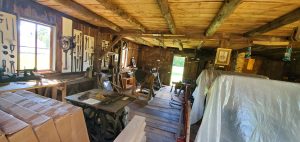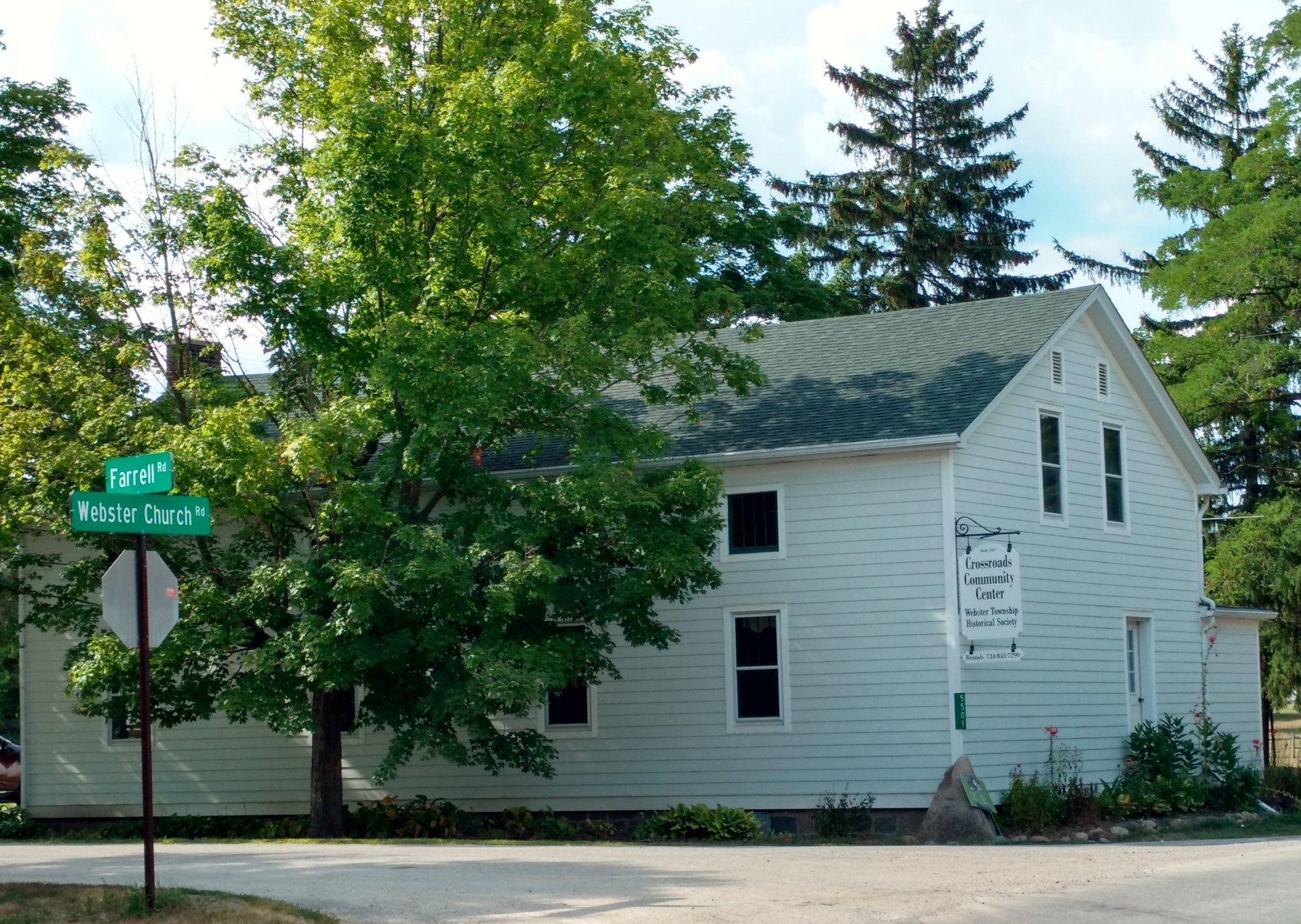
Moving this building to Historic Webster Village in 1985 was the first major project of the WTHS. Gracing the northeast corner of Historic Webster Village for 36 years with no repairs, our wheelwright and blacksmith shop required restoration. Today the Wheeler Wheelwright & Blacksmith Shop is a museum for old tools and has an operating forge, which is used annually at the Webster Fall Festival.
It now boasts new “hitching post” railings installed on either side of the improved entrance ramp. Windows and the upper and lower front doors were replaced, the back door now functions again, the bottom siding all around the building was replaced along with many boards on the exterior, and many woodpecker holes were filled. Re-stained to blend the new and old woods together, our wheelwright and blacksmith shop will stand proudly once again in the northeast corner of Historic Webster Village for many years to come.
The Wheeler Wheelwright & Blacksmith Shop in its newly restored condition.

Photos of the interior taken during the restoration process appear below.


History of the Blacksmith and His Family
After the opening of the Erie Canal in 1825, Michigan evolved from a wilderness to statehood by 1837. Pioneers were attracted to the territory by land which sold for $1.25 an acre.
Tillotson Wheeler was one of Webster Township’s first settlers, arriving in 1829 from New Hampshire. On December 3, 1830, he purchased 80 acres from the US Government in Section 15 of Webster Township and an additional 40 acres in Section 14 on October 28, 1835. After several years spent clearing the land, he farmed here for the rest of his life. He and his wife Polly Campbell raised 3 children John Campbell (1824-1898), Martha Stevens (1828-1847), and Guy Henry (1832-1868).
John Campbell Wheeler built the brick house on this land that still stands today on Webster Church Road just north of North Territorial Road. He and his wife Mary Harrison raised 5 sons: Stearns T., Victor “Jean” (1852-1924), Oral Jay, Frank Harrison, and Samuel Thomas.

Jean Wheeler never married but became a major landowner in the area. However, Jean did not enjoy farming, so he apprenticed as a blacksmith with a local master to learn the trade. Working with black metals–usually iron or steel–he operated a shop in the 28-foot square, 2-story building he and his father built on the original family farm in about 1875. Farmers nearby counted on Jean to fix their wagons, buggies, and sleighs. He also was skilled in making farm implements such as hay hooks, plow shares, and hand axes. In the 1920s, Henry Ford visited the shop and bought an old steam engine for his museum at Greenfield Village. Jean spent his leisure hours fishing at nearby Independence Lake, half of which he owned. However, due to illness, he was forced to retire from the blacksmith trade in 1914. Jean then built a general store on the property. This building was re-purposed by the last Wheeler descendant, Pearl Wheeler McMichael, who then owned the property, to be a home for her son and his family. It was moved across fields to a location a little over a mile away. Although condemned, it still stands today on that land.
July 2022. Board of Directors member Joanne Westman recently took a group of Northfield Library patrons on a tour of our buildings. During the stop at this building, Mike Cooley provided some new information. He explained that the wide floor boards were called “The Kings Pines.” These boards are over 24 inches wide which King George II preserved for building masts for his ships. Joanne also learned from the bus driver who brought the patrons to our village that one of our saddles is a “two horned saddle.” This saddle allowed a lady to place her right leg between the “horns” so that she could face forward for the first time. Another patron pointed out a long leather strap that could be used to power a lathe by attaching it to the wheel of a Model T parked outside the building.
Victor Jean and the Ann Arbor Car
Jean did some work for the Ann Arbor Car company during his years as a wheelwright. In return, the company gave him one of their cars. What happened to that car and where is it today? Click to find out.
History of the Building
Built circa 1875, the blacksmith shop sat idle after 1914 and gradually deteriorated as wild growth enveloped it–hinges failed causing doors to fell off, beams went askew and the building sagged, windows fell out, the roof no longer offered much protection against the elements, and the wind toppled the cupola. After almost 150 years of Wheeler ownership, the house, outbuildings, and a few acres were sold to Mr. and Mrs. Robert Beaugrand who donated the shop and its contents to WTHS. Because the mortise and tenon construction held the building upright, restoration was feasible.
On October 23, 1985, a crew of Amish carpenters from Quincy, MI, began the task of dismantling the standing structure and moving all of the pieces and parts about a mile down Webster Church Road to reconstruct the building on its new site in Historic Webster Village. Found inside were a lathe, tire bender, sleigh runners, spokes, hubs, and other miscellaneous items. The photos below illustrate the condition of the structure in 1985, and the work the Amish carpenters had to perform.






